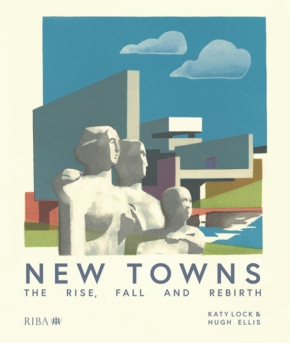New Towns: the rise, fall and rebirth
New Towns: the rise, fall and rebirth, Katy Lock and Hugh Ellis, RIBA Publishing, 2020, 180 pages, 140 colour and black and white illustrations, hardback.
The heritage of new towns was celebrated in Context 162, which built on an increasing awareness of the importance of new towns in understanding the development of our own country and others, particularly in the years since 1945.
This book traces the history of those towns in the UK from their antecedents in the garden cities through the post-war decades. It examines their current situation and their relevance today. It is a story of innovation in planning, landscape, architecture, and cultural and community development. The authors, Katy Lock and Hugh Ellis, both work for the Town and Country Planning Association. Both are keen advocates of new towns, and the ideas and aspirations that they stood for.
Lock and Ellis are not naive about the difficulties facing new towns today. These include maintenance liabilities for extensive open-space networks, the legacy of experimental housing design (often including flat roofs) built under pressure for delivery, and a uniformly ageing population and housing stock. Managing these problems was not helped by the premature winding-up of the development corporations in the Thatcher years and asset-stripping by central government (the early new towns were highly profitable). The Cameron government brought in the infamous permitted change of use from offices to residential: the conversion of Terminus House in Harlow is rightly described as ‘a low point in English planning practice’. Similar conversions may be in prospect for Central Milton Keynes.
The central section of the book sets out eight case studies, ranging from Harlow, one of the first generation of new towns, via towns in all the UK nations, to Milton Keynes, the last, most ambitious and greatest achievement of the new town movement. Some aspects of this picture are bleak but not universally so: the book shows how the private sector, local authorities and government agencies are rediscovering echoes of the innovative spirit of the early new towns to find solutions to their present problems. The authors decry the present situation of planning: reckless deregulation, a complete lack of strategic planning, with the partial exception of the Cambridge-Milton Keynes-Oxford corridor, and the lack of direction in government.
Towards the end of the book there is a picture of Vauban in Freiburg. Vauban and Freiburg are magnificent. The energy, courage, inventiveness, and ability to meet present and future needs evident there are qualities that not so long ago we used to have in the UK. We could confidently plan and build Milton Keynes, and other countries used to look to us for inspiration. Now we have no example of a city comparable with Freiburg that meets the particular challenges of the 21st century with such ambition, creating beautiful places in the process. We elect governments that believe that the best results come from a hands-off approach, but there is a glimmer of hope in that the achievements of Freiburg had their origins in community activism rather than waiting for top-down action by government.
It is a pity that this book is spoilt by patchy proof-reading. New Towns is an excellent and well-illustrated primer to the history of the new towns movement and to its relevance today. Lock and Ellis are straightforward in highlighting current failures but positive in showcasing successes.
Lewis Silkin may have been too ambitious in 1946 in anticipating that the new towns would produce a ‘new type of citizen’. No politician would say that now, but books like New Towns can at least keep the memory of that boldness of aspiration on life support, perhaps to reawaken one day.
This article originally appeared as ‘A glimpse of the possible’ in Context 165, published by The Institute of Historic Building Conservation in August 2020. It was written by Michael Taylor, editorial coordinator for Context.
--Institute of Historic Building Conservation
Related articles on Designing Buildings Wiki
- Birkenhead.
- Eco towns.
- French new towns.
- Garden cities.
- Garden communities and the historic environment.
- Garden communities.
- Garden towns.
- Harlow new town.
- IHBC articles.
- Institute of Historic Building Conservation.
- Levittown.
- New Town Development Corporation.
- New towns heritage.
- New towns.
- Post-war new towns in Germany.
IHBC NewsBlog
Images from inside a Grade II listed hotel show the scale of its collapse
The Corbett Arms in Tywyn has fallen into serious disrepair.
Old Sarum fire in listed (& disputed) WW1 Hangar - Wiltshire Council has sought legal advice after fire engulfed a listed First World War hangar that was embroiled in a lengthy planning dispute.
UK Antarctic Heritage Trust launches ‘Virtual Visit’ website area
The Trust calls on people to 'Immerse yourself in our heritage – Making Antarctica Accessible'
Southend Council pledge to force Kursaal owners to maintain building
The Council has pledged to use ‘every tool in the toolbox’ if urgent repairs are not carried out.
HE’s Research Magazine publishes a major study of the heritage of England’s suburbs
The article traces the long evolution of an internal programme to research 200 years of suburban growth
IHBC Context 183 Wellbeing and Heritage published
The issue explores issues at the intersection of heritage and wellbeing.
SAVE celebrates 50 years of campaigning 1975-2025
SAVE Britain’s Heritage has announced events across the country to celebrate bringing new life to remarkable buildings.
IHBC Annual School 2025 - Shrewsbury 12-14 June
Themed Heritage in Context – Value: Plan: Change, join in-person or online.
200th Anniversary Celebration of the Modern Railway Planned
The Stockton & Darlington Railway opened on September 27, 1825.
Competence Framework Launched for Sustainability in the Built Environment
The Construction Industry Council (CIC) and the Edge have jointly published the framework.















